Everything You Need To Know About Air Filters (And The Best For Your Budget)

After my recent article on the damaging effects of air pollution on our health, I started to take a closer look into the world of home air filters or air purifiers as some call them.
I already had a good understanding of water filtration systems as covered in my article Everything You Need To Know About Water Filters. Yet when it came to filtering the air, I must admit that I was a little lost.
I went into research mode which took me down many rabbit holes. I soon discovered that all air filter systems are quite simple. There is a fan that pulls in air from the room. Then this air passes through an air filter before returning to the room.
That's it.
But when it came down to researching the best type of air filter technology, I was still lost.
Enter Thomas Talhelm. I discovered Thomas through his Quora profile. His answers on air pollution and air filters have had over 1.4 million views!
After spending numerous hours (seriously) reading through his work, I was blown away! Not only did this guy know his stuff, but he also lived and breathed it, literally. He was out there experimenting with various filtration technologies and cutting through the marketing hype.
Best of all—he was living in ground zero of air pollution—China! Not only was Thomas able to see first hand the impact that various air purification devices had on bad air quality, but it was also handy that he lived near some of the world's biggest air filter manufacturers.
To cut a long story short, I reached out to Thomas and asked if he would be able to put together an article covering everything we needed to know about home air filters. He agreed!
Read on to learn why you do not need to pay top dollar for a home air filter system.
Everything You Need To Know About Air Filters
Hi, I'm Thomas Talhelm. I'm an Assistant Professor of Behavior Science at the University of Chicago Booth School of Business and the founder of Smart Air (a social enterprise to help people in China and India breathe clean air without shelling out thousands of dollars for expensive purifiers) and Sqair (the world's most cost-effective air purifier—which is currently running on Kickstarter HERE.)
The following article is split into two parts:
Part 1: The 3 Things You Don't Know About Air Pollution
Part 2: The Shockingly Simple Science Behind Air Purifiers And What To Look For When Buying An Air Filter For Your Home
If you are researching air filters for your home, I assure you that by the end of this article you will be able to make an informed decision and buy an air purifier that not only works but will cost a lot less than you may initially have expected.
Let's begin.
The Three Things You Don't Know About Air Pollution
You have heard of lead, right? It's that extremely toxic metal that virtually all of us have in our bodies.

I say “us” because the base rate is so high and also because I got my blood tested for lead recently in Beijing and it turns out I have 4.6 micrograms of lead per deciliter of blood.
That’s far below the hospital’s toxic limit but about double the amount found in the average American.

We’ve known for a while that lead hurts us. But how much lead is truly safe?
Before 1970, the safe level in the USA was 60 μg/dL.
Then people did more research, and they lowered the limit to 40 (1971).
Then... 30 (in 1978).
Then... 25 (in 1985).
And then... 10 (in1991).
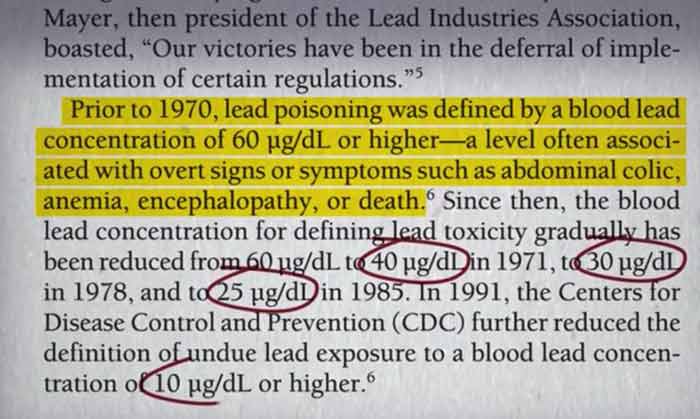
Now, it’s down to 5 (in 2012)—just above where I scored.
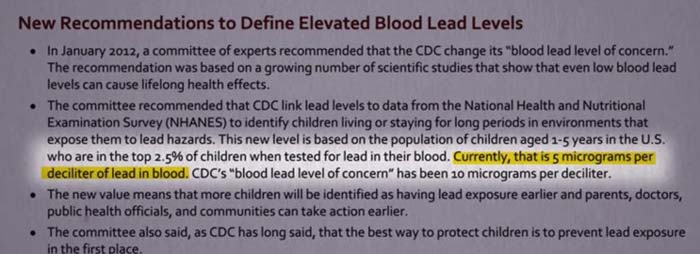
These progressively stringent guidelines for lead exposure are also being updated for air pollution.
Air pollution levels are determined by the particulate matter count. You may have seen the term PM2.5 or PM10 on air filter websites. The PM stands for particulate matter, and the number means particles smaller than that size in micrometers.
So PM2.5 means particulate matter in the air less than 2.5 micrometers in diameter. Which is extremely small—only 3% of the diameter of a hair.
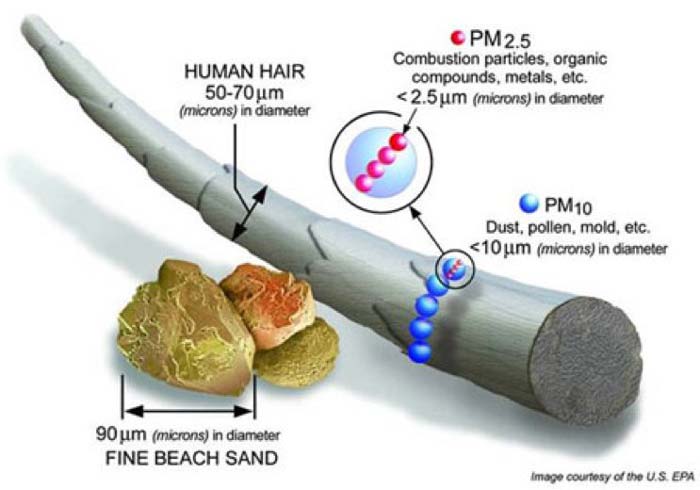
PM2.5 is the standard for measuring air pollution levels.
So just as we saw what happened with the 'safe levels' of lead, we are now seeing the same trends with PM2.5 air pollution.
The World Health Organization’s 24-hour limit for PM2.5 is 25 micrograms/m3. I’ve lived in China for six years. I lived in Beijing when the city averaged over 100 micrograms, and the world outside my window looked like this.
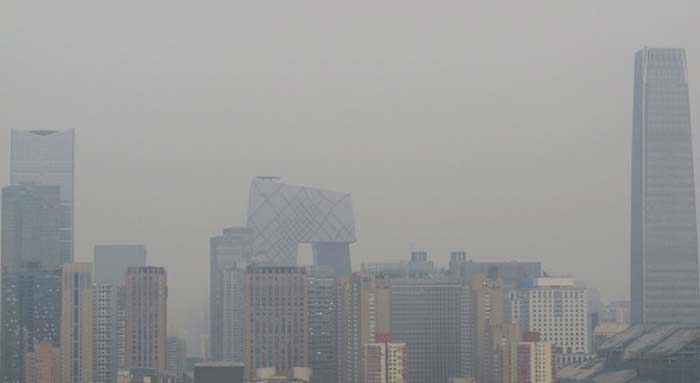
When I lived in an area that had a PM2.5 level of 100 micrograms, or during my Beijing trips—exposing myself to levels of 500 micrograms/m3, I felt like 25 micrograms was a safe target.
Twenty-five also sounds quite reasonable in London and Paris, which are safely under the limit.

But here’s the problem. In the last six years, I’ve been seeing more research showing that PM2.5 takes a toll on our bodies at much lower levels than we had previously imagined.
Newer research has been finding serious health effects from air particle exposure below the 'WHO safe limit standard' of 25 micrograms.
For example, researchers tracked Americans breathing air with 7.5 micrograms versus 12.5 micrograms of PM2.5. The findings found that people breathing the cleaner air with only 7.5 micrograms (remember, the lower the microgram number, the less particle matter in the air) had lower rates of metabolic disease.
And look at this: Purifying people’s air from 16 micrograms down to 11 micrograms was enough to meaningfully lower their blood pressure. And I don’t mean some insignificant change—blood pressure went down similar to the effect of exercise or reducing salt. In the entire population, this change would decrease heart attacks and strokes by 16%!
That’s why the latest air pollution research has totally changed my mind about the risk I’m facing. Eventually, as with lead, most researchers concluded that there is no safe level of lead.
Even “low” doses harm us. I think the same is quickly becoming true for PM2.5.
The Paradox Of Why We Should Worry More About Low Air Pollution Levels
There’s a crazy paradox that makes this even more urgent. Join me for a quick thought experiment.
Let’s say you could wave a magic wand and reduce PM2.5 by 25 micrograms in London or Beijing.
Your main goal is to save the most lives possible. Where would you put your magic wand to work? Would it be in Beijing—with the incredibly dirty air? Or would you help London—with the relatively cleaner air?
Put another way, imagine the relationship between PM2.5 and death. Would it look like this? Does the death rate accelerate as pollution levels increase?
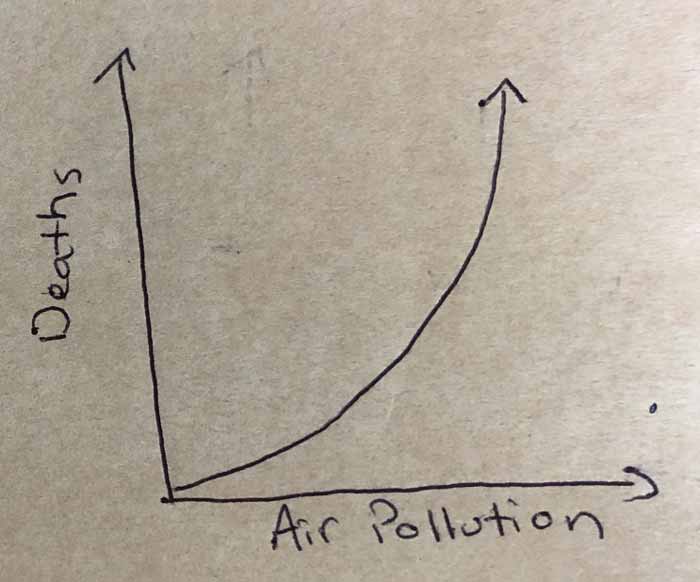
Okay, I’m not an artist, but you get the point. The hypothesis here is that air pollution hurts us little-by-little, but then the damage really starts to get severe at high levels.
This relationship makes sense. Lots of stuff works like that, such as the relationship between weight (BMI) and mortality.
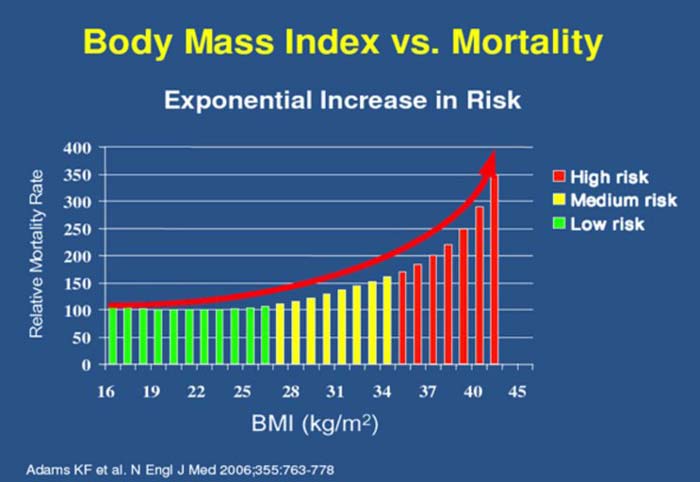
Or does a straight line makes more sense to you? That makes sense to me too. In that case, each step up in air pollution hurts us the same. Double the air pollution, and you get double the damage.
On a graph it would look like this:
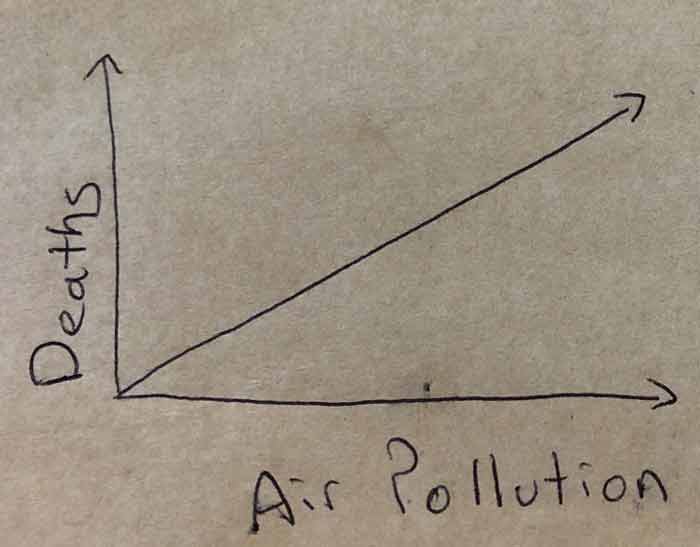
But scientists meta-analyzed all of the epidemiological studies linking PM2.5 to death, and the data says both of my intuitions are wrong. It’s the opposite! Lower numbers actually hurt proportionately more!
If we plot their findings on our neat hand-drawn charts, what we see is a pattern like this:

As air pollution levels increase, the rate of deaths slows down.
The exact graph from the scientists looks like this:

The above chart shows how many people die each year when the average amount of PM2.5 in the area goes up.
Even if you're not a stats nerd like me, we can all agree that's a very alarming correlation!
Here’s why that graph is so crazy. Let’s say China has a bad year, and air pollution goes from 125 to 150 micrograms. Based on China’s population, that’d mean 60 thousand more people will die.

Sixty thousand people would be a staggering number of lives to lose. Shockingly, that same increase—an increase of 25 micrograms—would kill almost twice as many people (per capita) if it happened in a cleaner city like Paris or Seoul.

Here’s why that matters. Oddly enough, it’s that first 15 or 20 micrograms that hurt the most. That’s why people in cities like Chicago, where I live, should be worried.
It's also why everyone needs to take air pollution seriously.
Oh, and going back to our thought experiment from earlier—given this data, those that thought China was the best place to wave the wand in order to save the most people would be wrong.
The best place to drop clean the air by 25 micrograms—to save as many lives as possible—would actually be the much cleaner London.
Common Beliefs Around The Health Effects Of Air Pollution Is Wrong
Out of curiosity, I Googled “air pollution health effects” to see what came up first. The first things that popped up were all in the lungs—asthma, bronchitis, lung cancer.

That makes sense considering we breathe polluted air into our lungs. Naturally, the particles should cause the worst problems there.
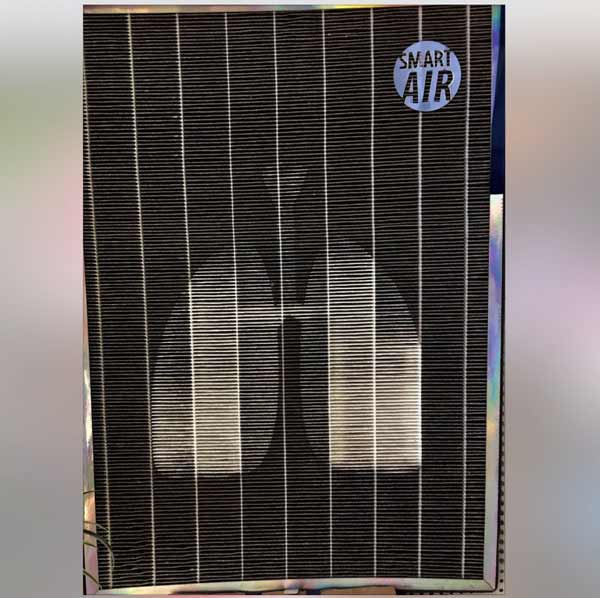
The problem is that this assumption is wrong. Yes, air pollution affects our lungs. But the biggest effects aren’t in our lungs at all. Air pollution doesn’t kill like you think it does.
That faulty assumption led to a lot of confusion. For decades, scientists ran studies where they gave people air purifiers and tested their lung function (like this). They often found purifiers had weak, non-statistically significant effects. So during that time, the consensus among scientists was, “Well, the evidence isn’t great.”
More recent studies found that we were looking in the wrong place. There are small effects on lung function, but large effects on inflammation and blood pressure (1, 2, 3). For example, this study found reductions in markers of inflammation of up to 60%.
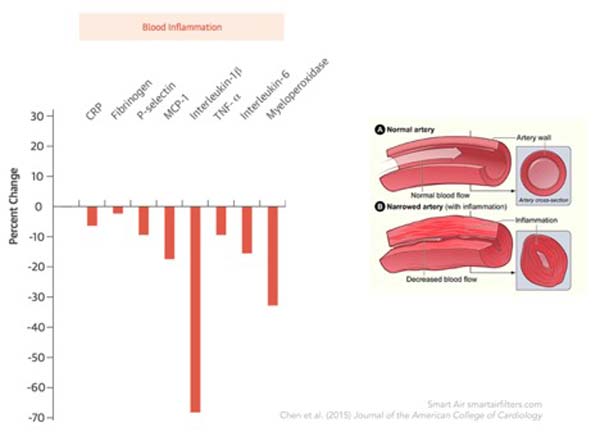
Harmful constriction in people’s blood vessels decreased by 30% on average.
However, when the researchers looked at people’s lung function, they found almost no change.
We’ve been looking in the wrong place the whole time. Instead of our lungs, we should be looking in our hearts and blood vessels.
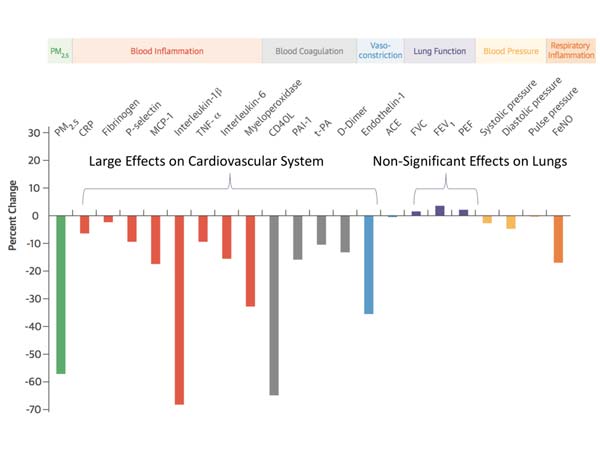
These short-term effects make sense when you look at the long-term effects. It can explain why, when the WHO tallied up all the deaths due to outdoor air pollution, lung cancer only counted for 14%.

Okay, but lung cancer is just one type of lung problem. What about emphysema, chronic obstructive pulmonary disease and other lung problems? Again, it's just another 14%.
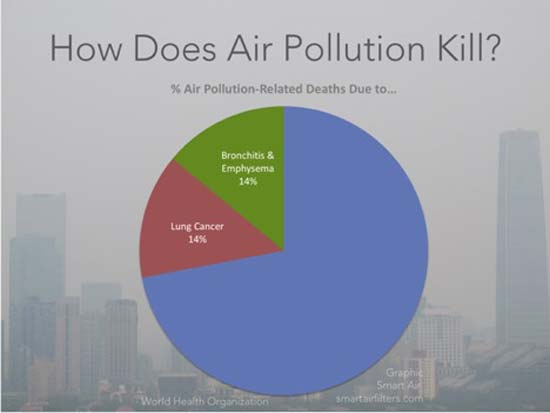
So what’s in that big blue slice? It’s the diseases affected by inflammation and blood pressure—heart attacks and strokes.
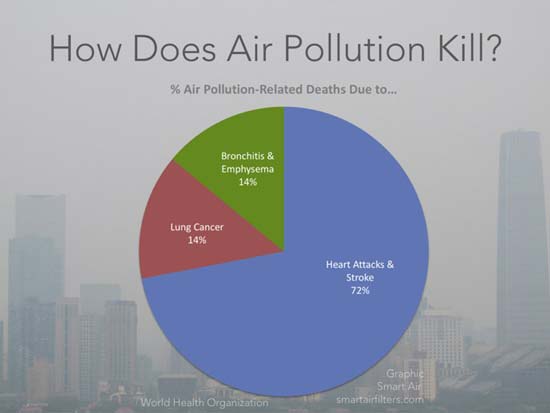
Everyone Is Affected By Air Pollution—Not Just 'Sensitive People' As Authorities Claim
When I look at the air quality index on my phone, I see this disclaimer that bugs me:
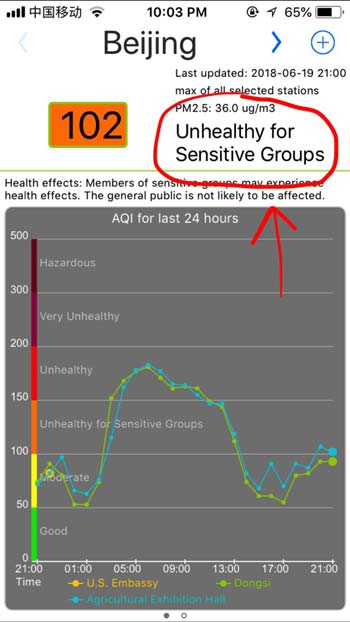
Unhealthy for sensitive groups? Well, I’m young and healthy. I don’t have asthma. So no big deal, right?
As it turns out, that’s wrong. Remember that study of inflammation and blood vessels? That was among healthy 20-year-old college students.

I imagine these students were like most students I interact with here in China—no apparent symptoms, no asthma and no complaints about the air. Meanwhile, these tiny particles are waging war on their blood vessels. In a Canadian study, researchers actually found more significant health effects among younger people.

To be fair to the EPA, what I think they mean to say is that “sensitive groups are more likely to experience obvious symptoms.” But the data is very clear on this—pollution in that range (and even lower)—is unhealthy for everyone.
As the data reveals—air pollution has systemic effects on our health and with the World Health Organisation's 'safe limits' shown to still be in the danger zone, it is no wonder why people are looking for the best air filter for their home.
Speaking of which, let's look at what you need to know before buying an air purifier.
Part 2: The Shockingly Simple Science Behind Air Purifiers
Now wait a minute, what do I know? I’m not an expert in air pollution. In my day job, I’m a social psychologist who does a lot of research in China.
I’m mostly just a relentless data nerd who wants to see empirical tests of everything before drawing conclusions. Then add in the fact that spending time in China put me on a path to care a lot about the polluted air I often breathe.
It all started in January 2013 when I was coughing through an "airpocalypse" in Beijing, and I was desperate.
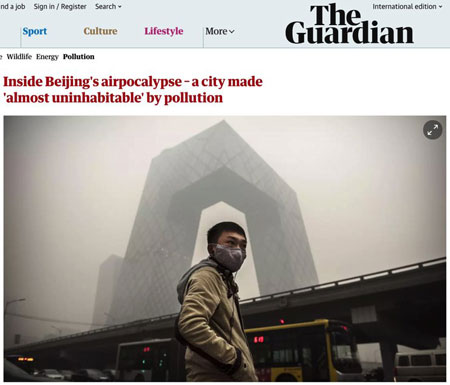
I wanted to breathe clean (or even just adequately safe) air. I started looking into air purifiers and found them absurdly expensive. The one I heard about the most was this $2,000 IQ Air.
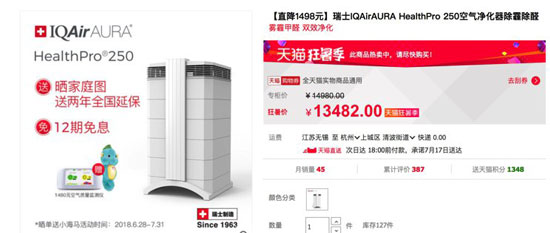
I saw companies touting their imported filters and proprietary technology.
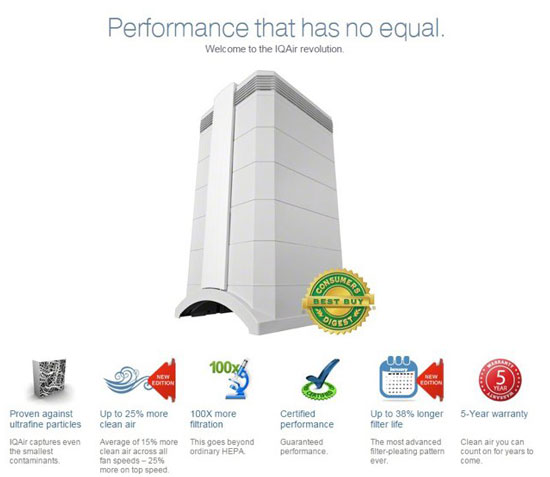
I saw “experts” with strict warnings against buying anything other than a “true HEPA filter.”
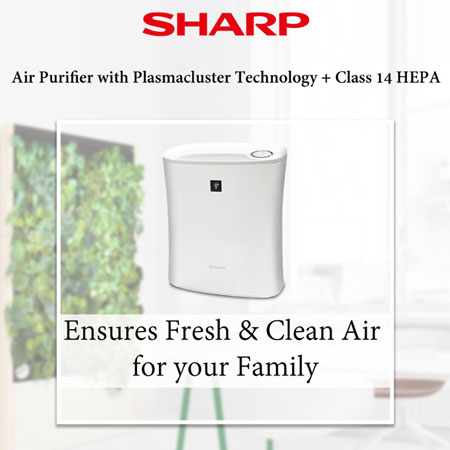
Even the “cheap” purifiers cost hundreds of dollars. A reasonable person could look at the market and conclude that there’s some sort of technology in that black box that costs hundreds or thousands of dollars.
Smart friends of mine sent me links to purifiers as expensive as that $2,000 IQ Air and told me they chose this one.
Still, I was skeptical. I wanted to understand how air purifiers worked first. I could sit here and pretend that I researched this for months, but the answer is so simple it just takes a few minutes on Wikipedia.
It’s not because I’m some genius that I figured this out. It’s because purifiers are stupid-simple machines.
Purifiers are just fans and filters. Let’s take that $2,000 IQ Air. I’ve opened one up before. Here’s how it works.

A fan pulls air through a coarse pre-filter and pushes it up through a HEPA filter. That’s it! That’s all you need to reduce particulate pollution in your home.
The term “HEPA” sounds sophisticated and scientific, but they’re nothing fancy. It turns out they were invented back in the 1940s, so they’re not patented. Anyone can make them.
The materials aren’t expensive either. They’re just mats of synthetic fibers, kind of like the shirt I’m wearing now. I didn’t pay $1,000 for this shirt.
So I bought a HEPA filter online for about $18 and strapped it to a fan I had at home. Here’s the beautiful fruit of my labor, my very first DIY purifier. (Here’s how you can build your own DIY purifier.)
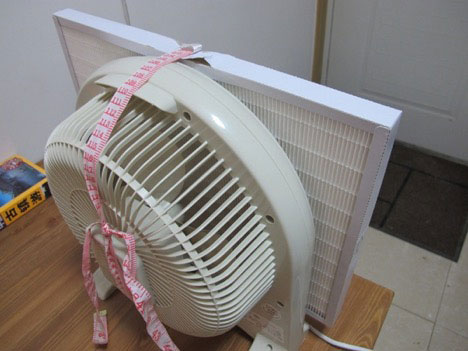
I wanted to know if it really worked. I bought a laser particle counter to test for microscopic pollutants in my air, including those dreaded particles smaller than 2.5 microns.
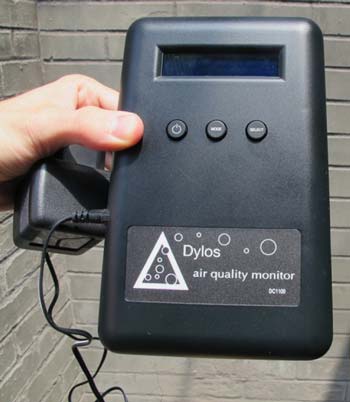
The data showed my $30 DIY purifier cut the amount of 0.5-micron particulate in my room by 84% on average (1, 2, 3, 4, 5).
You can see how my DIY filter compares to some $1000+ filters in the chart below. (Read about the experiment in full HERE.)
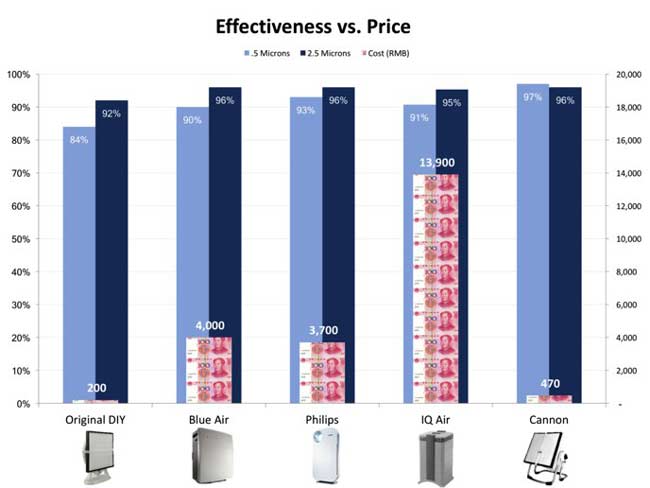
A souped-up version with a stronger fan (the Cannon) reduced particulate by 97%. (All the data and methods are open source). This only costs $70. That's still much lower than the high-end filters my friends purchased.

I was so excited by this revelation that wanted to tell the world.
I started a group called Smart Air to ship these no-nonsense purifiers to other air-breathers-in-need. As I started ramping things up from DIY home project to social enterprise, I tested all the filters from all the manufacturers I could find.
All of that testing taught me this about filters—for best results, there are only two air filtration technologies you need.
Types Of Air Filters: The Only Two You Need
What I found was that I really just needed two types of filters. It probably sounds like a grand claim, especially with so many purifier companies touting their “unique” technologies and 7-stage filtration (with pre-filters, plasma array filters, activated carbon filters, HEPA filters, photocatalytic oxidation filters, UV filters, negative ion generators...), but two filters are all you need. Here’s why (with data).
There are two natural kinds of air pollution—particles and gases.
To purify the air in your home, you need to remove both of these things.
1. Particles—HEPA Filter
Let’s look at particles first. According to the WHO, particulate pollution “affects more people than any other pollutant.” It’s my biggest concern.
Fortunately, to capture particles—and I mean virtually every particle—a HEPA filter is all you need.
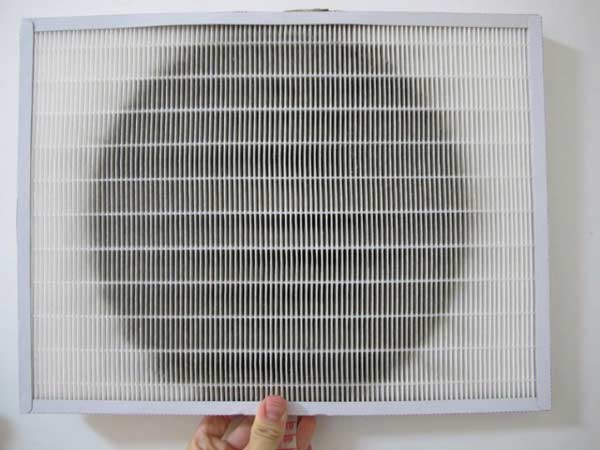
A simple HEPA filter (that has done its job!)
These simple filters capture almost all particles. At first, I was misled by the common definition of HEPAs—that they capture 99% of particles 0.3 microns and above.

Reality is far odder. It turns out that HEPAs (and masks and furnace filters) are actually better at capturing particles smaller than 0.3 microns. (I’ll explain more below.)
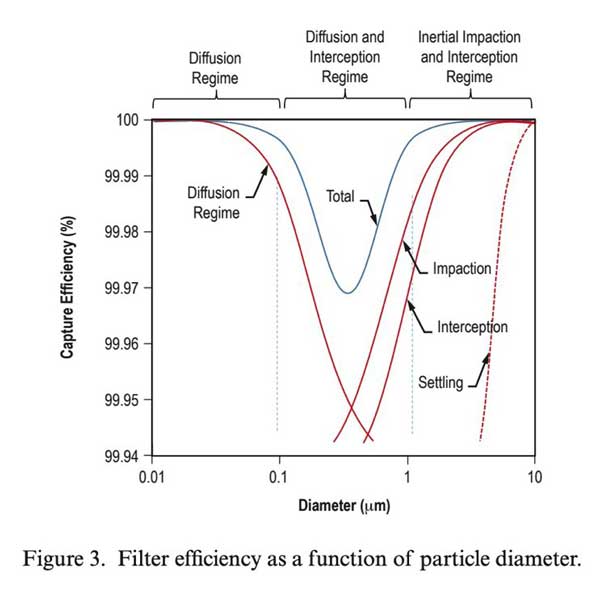
People have asked me about lots of specific particles—do HEPAs capture dust mites? Pet dander? Asbestos? Bacteria? Mold? The answer is yes.
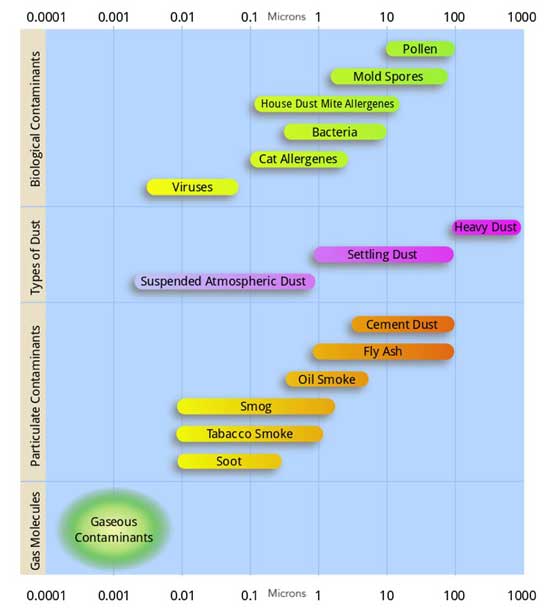
Here’s an easy way to answer whether a HEPA filter will capture the particular particle you care about: Is it a particle? If yes, then yes, a HEPA filter will capture it.
2. Gases—Activated Carbon Filter
The other category of air pollutants includes various gases including chemicals that usually come from indoors—things like formaldehyde off-gassing from furniture, chemicals emitted from cleaning products, and even chemicals coming from wrinkle-free “treated” clothes.

Gas pollutants can also come from outdoors. Outdoor gas pollutants are usually gases like nitrogen dioxide (NO2), sulfur dioxide/sulfur dioxide (SO2) and ozone, which often come from car exhaust and industry.
How do we get rid of these gases? HEPA filters won’t help because HEPAs only capture particles. Instead, what’ll capture these bad guys is activated carbon.
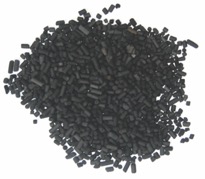
Activated carbon surprised me in how versatile it is. I ran real-world tests to find out whether carbon works or not, and the data showed carbon captured volatile organic compounds coming from cigarettes (probably including a fair amount of benzene).
You can read about that experiment HERE. I have included some of the charts from that experiment below:
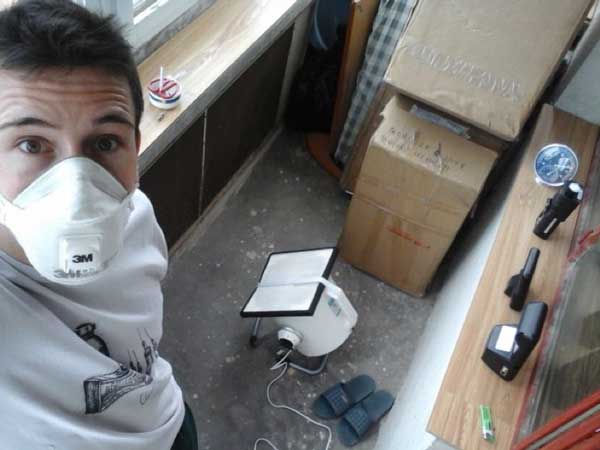


I also arranged another experiment where I tested a carbon filter's ability to remove formaldehyde and also whatever other unknown chemicals were coming out of the Smart Air office’s new flooring and wallpaper then I demonstrated this in a time-lapse video.
The results from that experiment using the carbon filter can be seen below:

Carbon is so versatile that it’s hard to track down every single gas that it can capture. My tests (and scientific studies) have found that carbon captures (1) indoor chemicals such as formaldehyde and (2) major outdoor pollutants like ozone, NO2, and SO2. Thus, a simple activated carbon filter will help reduce the major gas pollutants of concern to me.
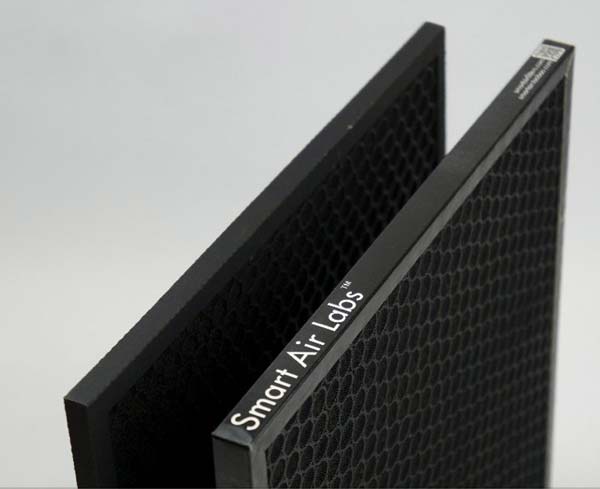
So that’s it! Two filters will protect you against basically everything—at least the most common air pollutants you are likely to face in your home.
Important: Carbon Filters Have Two Limitations
Okay, I’ve made things sound pretty simple so far. And removing particles really is that easy. But carbon filters are not as impressive as HEPAs.
For one, HEPA filters capture 99% of particles in a single pass, but carbon filters aren’t as efficient.
For example, this study found that carbon filters captured different chemical gases anywhere between 5% to 60% in a single pass—sometimes lower.
Carbon also gets “full” and loses effectiveness, so the more carbon the better. Unscrupulous purifier companies put a tiny bit of carbon into a filter so they can advertise that they have carbon. But that carbon will get full in a hurry and become useless.
Carbon bottom line: If you’re worried about gas pollutants or chemicals, look for a carbon filter with lots of carbon and change the filter frequently.
If It's Really So Simple, Why Do People Spend Big Dollars On Expensive Air Filter Systems?
It's clear—to filter your air, you only need two inexpensive filters. A HEPA filter and an activated carbon filter. That’s pretty awesome, right? Why don’t more people know about this?
I think one contributing factor is that air purifier companies don’t make money from simplicity. Businesses make money by claiming they have proprietary technology (that the owners are often unwilling to have tested by third parties), fancy imported filters (that they also don’t want to have tested) or some other "advantage" that conveniently involves you paying a large amount of money.
One of the most common tricks out there is to package the facts above as if it’s something special about their purifier. Here’s a well-known brand doing just that:
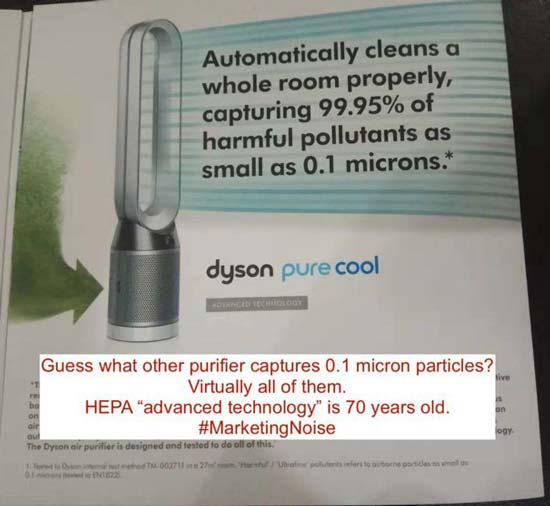
Common Filter Features—Must Have Feature Or Marketing Ploy?
I know what you are thinking, "Surely, two simple filters on a fan aren't enough! It must be more complicated than that, right?"
Let's run through the typical "features" that result in people paying far too much for their air filter:
Pre-Filters
If there’s one other filter to add to your purifier, a pre-filter is helpful.

Pre-filters don’t improve performance. What they do is capture large particles which your HEPA filter would otherwise capture. The benefit is that they spare your HEPA filter by allowing it to last longer.
Filtering Smells
Many smells are volatile organic compounds, which means carbon filters help capture smells. Scientists tested the effectiveness of carbon for neutralizing foul odors and used real human noses to judge the effectiveness thereby proving carbon worked.
Washable HEPA Filters
A big problem with HEPA filters is that they eventually get full, and you have to throw them away. Never fear! Some companies claim to have washable HEPA filters to solve that problem. Some purifier “experts” also recommend simply washing your HEPA.
The data nerds at Smart Air tested both vacuuming and washing HEPA filters. Surprisingly, the results showed that washing HEPA filters actually worsened performance. I have yet to see an empirically proven washable HEPA filter. Until I see actual data, I’m not convinced that any HEPA filters are washable.
Smoke
First, what is smoke exactly? Smoke contains particles and gases.
For particles, we know the HEPA covers us. For harmful gases like VOCs released from burning, the activated carbon filter has us covered. (Please see carbon monoxide below.)
CO2
Carbon dioxide builds up if people are in an enclosed, unventilated room. At moderate levels, CO2 makes people tired. At very high levels that you’re unlikely to find in your home, CO2 can make people sick or even die.
Activated carbon filters on the market don’t meaningfully reduce CO2. Short of buying a submarine grade CO2 scrubber, the best way to reduce CO2 is to bring in outdoor air.
![]() Diesel Exhaust
Diesel Exhaust
Diesel exhaust contains gas pollutants like NO2 and particles.

HEPA filters capture the particles, and carbon filters capture the NO2.
Carbon Monoxide
Experimental studies have found that activated carbon captures carbon monoxide, but I wouldn't count on it. Carbon monoxide can be incredibly dangerous. If carbon monoxide posed any threat to my indoor environment, I would not rely on a carbon filter! I would quickly move somewhere else!

Ultrafine Particles
Forget about wimpy 2.5-micron particles—ultrafine particles are where the real danger is, right?
I once got an email from a guy who sleeps in a plastic bubble because he’s paranoid about the nanoparticles in the air.
The crazy thing about HEPA filters (and Brownian motion) is that they’re actually better at capturing ultrafine particulate (< .1 microns) than particles around 0.1 microns. (I cover some empirical demonstrations of that here and here).
HEPA filters have the hardest time filtering particles at 0.3 microns in size, but the truth is they’re incredibly good at capturing particles across the range. We’re talking about a difference between 99.X% and 99.Y%.
Ultrafine particulate bottom line: You can toss out your sleeping bubble. HEPA filters will capture ultrafine particles too.
Ionizers
Ionizers don’t require you to buy new filters, and they’re very low noise. (Read How ionizers work for more...)
The only problem is that tests find that ionizers are terrible purifiers (1, 2). Not to mention, they generate ozone which is harmful. Skip the ionizer.
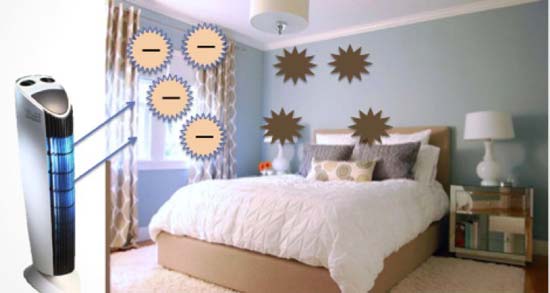
Ozone Generators
From what I’ve read, ozone generators are pretty good purifiers. The only problem is that ozone harms and even kills people. I recommend you skip the ozone generator.
UV Light
Some purifier companies put ultraviolet lights in purifiers because UV kills bacteria. It does, but not in the short amount of time it takes air to whip through an air purifier (according to the EPA). Skip the UV light.
Plasma Iodide Plutonium Nano Ultra Technology
If you look long enough, you’ll find a company making a claim about some technology that I haven’t addressed. Molekule is a good example.
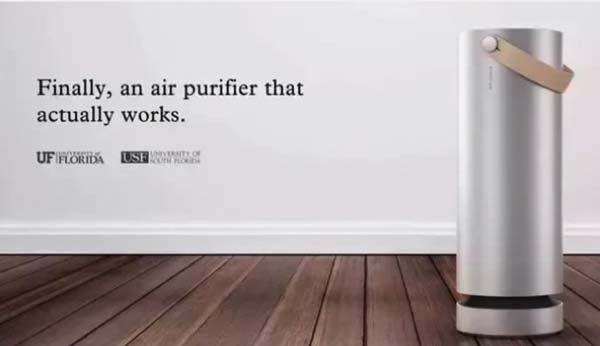
It’ll sound better. It’ll cost more. And people will want to know if it works better.
Everything You Need To Get A Quality Air Filter—Without Getting Ripped Off
Before pulling out your wallet, remember that simple technologies (fibers and carbon) already clean your air and are pretty cheap. If the new technology is so great, I’d wait until I see third-party tests empirically demonstrating that the new technology:
- is more effective
- lasts over time (not just for a short demonstration)
- doesn’t produce some new harm that we don’t yet know about
That sounds like a very high bar, but air purifiers are pretty darn good on their own.
Don't get caught up in marketing hype and end up spending more than necessary on a quality filter for your home or office.
Remember all you need is a fan, a HEPA filter and a carbon filter. With just those few things, you will have a system that is going to remove particles and gases from your environment.
So What Air Filter Should I Go With?
Alex here again. Fascinating stuff! Those thousand dollar air filter units are simply a fan with a few filters attached.
As for which filter you should purchase after all of this, it's really up to you. Hopefully, from the data presented in this article, you can now make an informed decision when buying an air filter.
I will be reviewing some of the leading air filters on the market (and some of the lesser-known brands), so be sure to sign up for my email list to be the first to hear about this.
I will be releasing an article reviewing a range of home air filters, including the EnviroKlenz Mobile System, The Molekule, The Sqair and even an ultra-low-cost DIY setup using SmartAir panels.
If you can't wait for those reviews, then you may want to check out the Sqair Kickstarter campaign HERE or have a go at building your own DIY filter using Smart Air's HEPA and carbon panels.
Whatever you do, be sure to join my email list and post a comment below.
Items Mentioned:
Found This Interesting? Then You Might Like:
- The Crippling Effects Of Air Pollution On Human Health (+Best Solutions)
- How To Detoxify Your Home Using These Amazing Indoor Plants
- Are You Being Exposed To Dangerous Flame Retardants?
- Toxins and Fat Gain: What You Need To Know
- Everything You Need To Know About Water Filters (And The Best Filter For Your Home)
- Confused About What's Healthy And What's Not? Read This
Get FREE Updates & EXCLUSIVE Content
Join Over 30,000+ Subscribers!


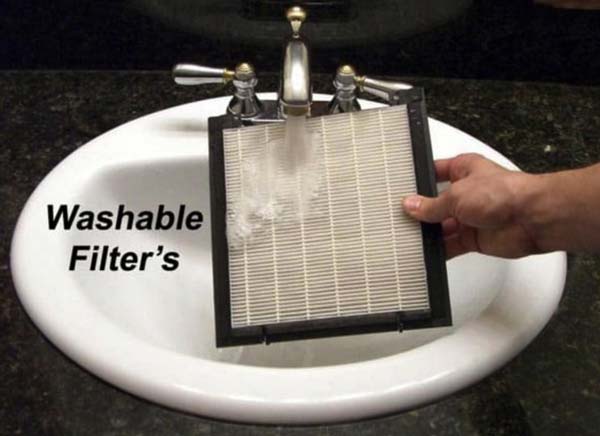
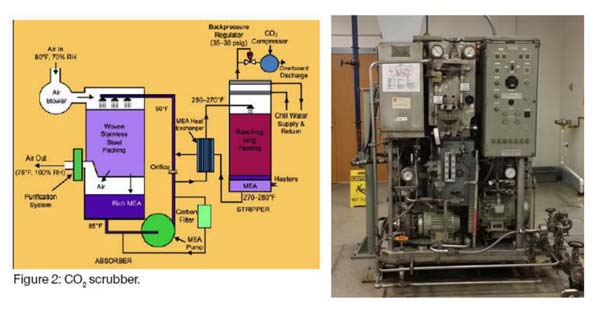 Diesel Exhaust
Diesel Exhaust





